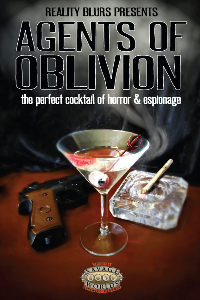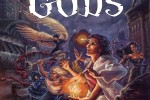Agents of Oblivion
Agents of Oblivion is a complete setting for Savage Worlds published by Reality Blurs.
By Sean Preston

Welcome to the twenty-sixth Designer’s Diary, a regular column where designers are given the opportunity to take readers on an in-depth ride through the design and development process of their system, setting, or product. If you’d like to share your product in the Designer’s Diary column, send a message to aaron@roleplayerschronicle.com.
Designer’s Description
Agents of Oblivion is what I like to call the perfect cocktail of horror & espionage. As presented in the core book, it is very much a sandbox setting wherein you can play anything from straight up espionage in the vein of Bourne to the more cinematic stylings of Bond and can add in elements of supernatural anywhere along the sliding scale that you see fit.
Purpose
Agents of Oblivion (AoO) came out of my desire to create a spy setting for Savage Worlds. Back in 2004, I created an overview of the stable of settings I eventually wanted to develop for Reality Blurs. The list covers a spectrum of genres, and one by one I’m ticking them off the list. RunePunk, Iron Dynasty, and Agents of Oblivion are three of them. Savage Worlds has been screaming for a modern setting from the inception, and I wanted to give the fans something they could really sink their teeth into. The challenge was to strike a balance between setting and mechanics, and in the latter case, to ensure there was a depth for those who wanted it that could be put to the side for those who didn’t want the level of granularity we offered.
Influences
The greatest influence was Splinter Cell. It was the catalyst which got AoO going. I saw this game which was at once compelling and immersive, yet it had appeal to more casual gamers. I wanted to capture the essence of some of the game play features, such as how they had loadouts that were focused and robust as well as appealing to different play styles. I’ve also been immersed in all the James Bond movies from my youth (as well as reading the Ian Fleming novels) and I wanted to marry some of those elements into this work. The X-Files was one of my favorite shows as well. I wanted to take the best bits of what I liked and put them into a cohesive whole. I was not oblivious to the fact that other spy and horror games exist out there, and while some of them are amazing (such as Spycraft 2.0 and Dark Matter), I wanted to create something at once comprehensive and simple.
Research
When I first began the Agents of Oblivion journey, I didn’t know as much about the nuts and bolts of things as I would like. I got to sink my teeth into research. As this was the first project post-RunePunk (where most of the materials were created from whole cloth), I read a lot of stuff and saturated myself with source material. This is where I realized I truly enjoyed research—it’s something I continue to do on all our projects to date. I watched scads of spy movies as well as The X-Files series (again), and mined the Internet for spy information. I revisited books and materials I had read in the misty past, such as Spycraft 2.0, and read through other books I had not read before formulating the base design of AoO (such as Dark Matter and Delta Green, and was relieved and delighted to find my work in its own space).
When people compare your pitch to other existing properties, they are trying to relate it to what they already know. This is something I should’ve known, but didn’t, so I read copious amounts of stuff, including books on special forces and all that sort of thing. Execution can be everything. I became friends with Pat and Alex of Crafty Games when I did the True20 iteration of Agents of Oblivion, and they saw AoO as its own beast. To put a cap on this question, part of this research has just been living the gamer’s life, and part of it was knocking off the cobwebs, and revisiting things I had played and was aware of growing up, such as Top Secret and James Bond 007 RPGs. It was my responsibility to parse through all this information, and apply it as necessary. There is a natural desire to show off all the information one learns. I am nothing, if not restrained in my application of the utility of materials deemed suitable for final inclusion in our work.
Art Direction
I’ve been lucky enough to have worked with Cheyenne Wright for a number of years on various projects. While I wanted to work with him on RunePunk, it just didn’t happen, and the first real opportunity came about with Realms of Cthulhu, where he not only created some great interior pieces (such as the retired adventurer, one of my personal favorites), he designed the Realms of Cthulhu logo, and the highly-praised investigator’s dossier. He also did all of the mon (provincial crests and character sheets) for Iron Dynasty. I had long done things the traditional way that has been expected—lots of art pieces, two-columns, and that sort of thing—but I wanted to shake things up. This wasn’t exactly the vibe I wanted to take the company. I wanted a more austere, clean look.
While I am proud of the collaborative design work I’ve down on Realms of Cthulhu and Iron Dynasty with top-flight layout folks, I’ve been striving to get to a particular place with the look and feel of our work. While art is important to a lot of gamers, the pieces should be there to support the work. Some folks want more art. I can’t dispute that. With the advent of tablet technology, I’ve found less is more (for myriad reasons).
Cheyenne and I have been talking about the art look for AoO for years. I gave him the challenge of creating the look and feel for the setting that both evoked the sensibilities of the sixties without losing a modern sense of style. He achieved that neatly. Having him do all the art gave a sense of continuity throughout the work. For specifics, I detailed about half the art pieces (along with the cover) and he created a punch list of the remaining pieces he wanted to do. This is unlike any art we’ve seen Cheyenne do before. I think he felt free to push his boundaries because of the trust that has blossomed between us over the years. (But, then, you have to trust a guy who’s won three Hugos, right?) I gave him a lot of creative space to exercise within the parameters I set forth, knowing full well he’d deliver in spades. You’ll be seeing more of his work in some upcoming AoO releases, you can be assured.
Gaming Experience
Agents of Oblivion is, at its core, a high-action espionage game sprinkled with twists and turns and strangeness. At least, it is for me. For you, it could be a slow-burning conspiracy with alien shadow masters. That’s the beauty of this setting. It can be different for all of us, yet we’ll all be sharing a common experience of “playing a spy game”. We expect people to mess around with it and tweak it out, to make it their own. For all of us, I’d say it’s a game of “good guys vs. bad guys”. However, the good guys may not always be good, and the bad guys may not always be human—they could easily be alien, demonic, or supernatural in origin.
Comparison
I’m generally reluctant to place our work against that of others in the genre, but I’m going to make an exception in this case as folks have already comparisoned Agents of Oblivion with a few other games that fall into this same general category. Chill, Conspiracy X, Dark Matter, and Delta Green spring most readily to mind. Along with Spycraft 2.0, but we’ll get to that in a minute. AoO is in its own space. It shares the conceit of an organized force working against dark forces (with the first three) and trained (not necessarily so organized) guys against the bad guys (with DG). The thing is, it shares more spiritually with Spycraft 2.0 in its application of offering a fundamental variety of play styles than with the former games. It differs from the latter with the incorporation not only of a de facto setting (lightly touched upon) and framework, but goes farther afield with the integration of powers. What we’ve done with AoO is to provide something requiring very little prep for the Director and for the players to leap into the game in just a few minutes and focus on the fun of being a spy!
Development Process
Agents of Oblivion began its life in 2004 when I first conceptualized it. I sketched out a few ideas, created a mockup logo (which was used in Starfall Jungle, maybe) and set it to the side for a bit. I returned to it more seriously when I submitted it into the True20 Setting Search where it became a finalist and was included in True20: Worlds of Adventure book (where it was highly popular).
The adventure came first, then the setting. Yes. I know, backwards. It was another time. I was another person. It was just me and the mouse in my pocket. I had planned to originally release this for True20 first, but things were moving pretty steadily for me—it’s kind of a blur (no pun intended)—and I was unable to get back to it for little more than snippets from time to time. I ended up chatting with Ed Wetterman about the possibilities of a shared universe, and we worked out a general overarching history (with him as the primary architect and me as editor and general naysayer). This stuff didn’t make it into the book, but will point the way in the future, most likely.
I developed the whole Oblivion-Pandora dynamic along with the bulk of the first draft. Here’s the heartbreaker. Despite having a system backup (which later turned out to be corrupted), I lost a lot of material. I gathered bits from Ed and Erica Balsley (both given special thanks in the credits) and began rewriting what I could from memory. It was weird reconstructing material in this manner. We were focusing on Savage Worlds as our fan base there was continuing to grow. Other projects competed for my time, so finally I asked Ed if he would be the Line Dev, so we could get this thing out the door. He took over and did a lot of hard work.
We worked closely together on this, making it a truly collaborative effort. We were also quite fortunate to have Dave Olson to really bring his “A” game when working on the weapons, and a great crew of folks including Brad Bell, Norm Hensley, Jeff Scifert, and my local gamer guys, Randall Orndorff (who insisted and contributed some material in the eleventh hour I had no intention of including) and Aaron Lehman. I should close by adding my choice to personally handle the layout enabled us to have finer control over the finished project with regards to adding and clarifying text and making rapid editorial changes.
For me, Agents of Oblivion represents the finest elements of Reality Blurs coming together to present you the finest in horror espionage gaming.



